Table of Contents
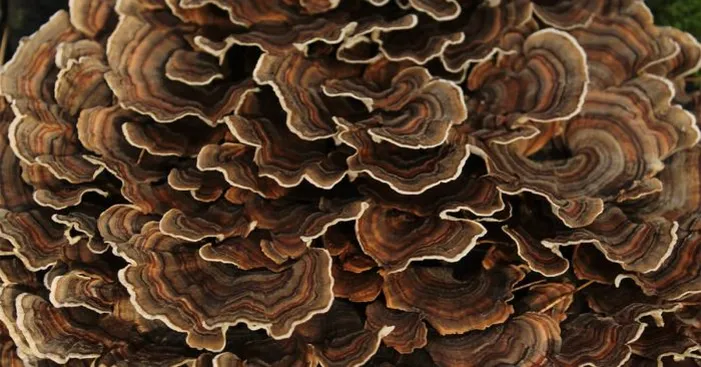
Turkey tail mushroom benefits are beyond what a normal mushroom could offer.
This mushroom is probably the most scientifically studied one and all of the information on its health virtue comes with anecdotal pieces of evidence.
In this article, we gathered all the information you need to know about the turkey tail mushroom, how to differentiate between a turkey tail mushroom and other similar mushrooms, the benefits and possible side effects of turkey tail mushroom with tips on how to buy and store it.
Turkey tail mushroom: overview
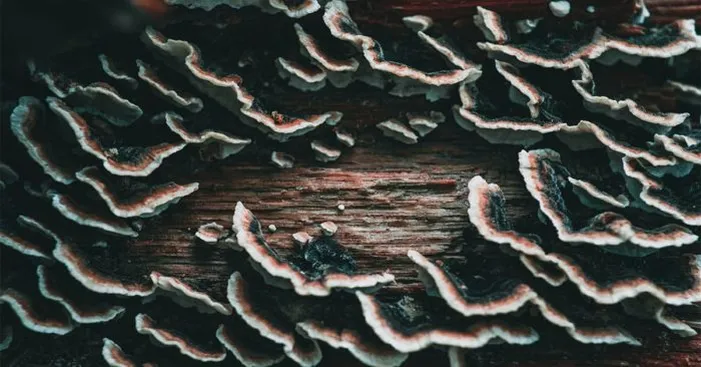
Turkey tail mushrooms are among the Trametes Versicolor family which are famous for their medicinal properties.
This mushroom grows on dead wood logs across the world and earned its name from its shape and the way they are colored like a turkey tail.
In addition, this mushroom has an oyster shape of thin circular structures that resembles leaves.
It is also among the easiest mushrooms to find as you can simply find them while looking down in a wooden area.
This mushroom is called Kawaratake in Japan and Yunzhi in China and it has been used since the 15th century for its medicinal properties.
Ancient Amerindian societies generally consumed turkey tail mushrooms dried, in soup or tea.
Since 1990, the turkey tail mushroom has been the subject of many studies and is probably the most documented mushroom in the scientific literature.
Turkey tail mushroom benefits and nutritional values:
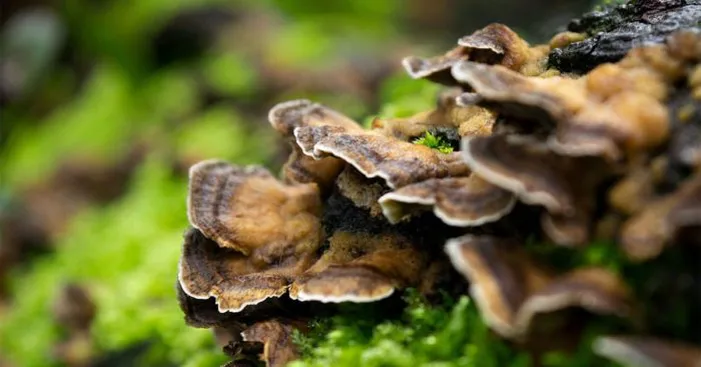
Nutritional values:
This vegetable is loaded with micro-nutrients including high amounts of vitamins, minerals, and plant-based components.
For instance, the turkey tail mushroom offers a huge amount of B vitamins which makes it one of the top sources of these nutrients.
In addition, they are also a great source of minerals, especially selenium and zinc.
Most people already believe that mushrooms in general are very full of nutrients that can have many health virtues such as:
Turkey tail mushroom benefits:
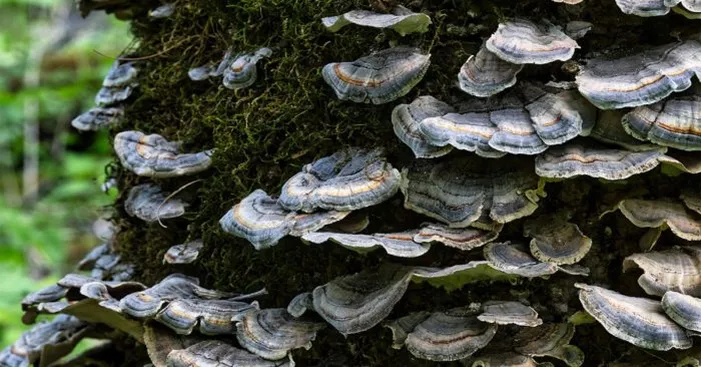
Improves intestinal health:
To keep your intestines as healthy as possible, your body needs to maintain a good balance of gut bacteria.
This is because gut bacteria have a direct interaction with immune cells to promote an immune response.
Turkey tail mushroom is a good source of prebiotics that can be a good source of food for your gut bacteria.
Many studies show that consuming turkey tail mushrooms can suppress the growth of harmful bacteria such as Shigella and E coli.
For instance, once you consume these mushrooms regularly, they increase the populations of Bifidobacterium and lactobacillus.
Our intestines need these two bacteria to fight symptoms like diarrhea, high cholesterol levels, and certain cancerous infections.
Offers polysaccharides:
This type of mushroom contains polysaccharopeptides (PSP) and Krestin (PSK), two types of protein-bound polysaccharides.
These two components have powerful anti-inflammatory and immune-stimulant properties.
In fact, both PSK and PSP inhibit and activate certain immune cells and suppress inflammation which promotes a good immune response.
Some studies show that PSP increases the amount of certain white blood cells called “monocytes” which can fight infection.
On the other hand, PSK stimulates the production of dendritic cells which regulates the immune response against toxins.
PSK also activates other white blood cells referred to as “macrophages“ and these cells can protect the body from bacteria.
Thanks to their powerful immune properties, PSP, and PSK are both used in chemotherapy and anti-cancer treatments.
Effective as part of an anti-cancer treatment:
Thanks to its beneficial properties, turkey tail mushroom is commonly used as a natural drug with chemotherapy.
In fact, a lot of studies show that cancer patients who included turkey tail mushrooms in their treatment had a better survival rate.
These studies mainly focused on people with rectal, gastric, and breast cancers treated with this mushroom.
The results show that these patients lived longer than those who only took chemotherapy.
Prevents the cold and the flu:
One of the most known turkey tail mushroom benefits is fighting infections of several illnesses like flu and the common cold.
This mushroom boosts the immune system and makes it very resistant to germs and bacteria.
In that sense, it is very recommended to include turkey tail mushroom on your diet when the flu season approach to keep yourself protected.
Other health benefits:
- Enhances physical performance.
- Reduces fatigue.
- Lowers blood sugar levels.
- Increases insulin levels.
- Antibacterial properties.
- Prevents HPV.
- Reduces inflammation.
- Rich in antioxidants.
Benefits of other mushrooms:
- Reishi mushrooms are a great source of polysaccharides which can stimulate the production of white blood cells.
Consuming these mushrooms would have a good impact on our emotional and physical state as well as the immune system.
In China, Reishi mushrooms are known as “the mushroom of immortality” and is one of the main food that Taoist Monks consume. - Maitake is a very famous mushroom in Japan and it comes as a huge chank that weighs several pounds.
Traditionally, people in Japan refer to this mushroom as the “dancing mushroom”.
The legend says that when people discovered it in the forest they were so happy with its benefits that they all started dancing.
Maitake mushrooms helps regulate blood pressure and boost the immune system thanks to their rich nutritional composition. - Chaga mushrooms are a type of parasitic fungus that looks brown and black almost like coal.
This mushroom has an amazing reputation for being one of the best natural drugs to use for anti-cancer
Also, Chaga mushrooms have a great impact on the stomach thanks to their powerful anti-inflammatory properties. - Cordyceps is one of the most expensive mushrooms in the world due to the difficulties of harvesting.
In fact, cordyceps mushrooms grow inside dead caterpillars and just 1 pound can cost more than 8000$.
This mushroom is praised for its aphrodisiac effect as it improves physical endurance and increases energy. - Lion’s mane mushrooms are a great source of beta-glucans which can reduce the levels of bad cholesterol.
These mushrooms also have great anti-diabetic and anti-cancer properties.
It is particularly recommended for nerve-related diseases such as Parkinson’s and Alzheimer’s.
Finally, Lion’s mane is used in traditional Chinese medicine to improve cognitive abilities.
Precautions before you consume turkey tail mushrooms:

Generally, turkey tail mushroom is full of benefits and is safe to consume.
Nonetheless, there are some reports of people experiencing some side effects after consuming it.
Most of the side effects these people had were bloating, darker stool, and stomach cramps.
Also, some people have reported a darkening in their fingernails after regular consumption of turkey tail mushrooms.
In addition, cancer patients who consume this mushroom as part of their treatment may experience nausea, loss of appetite, and vomiting.
Buying turkey tail mushrooms:
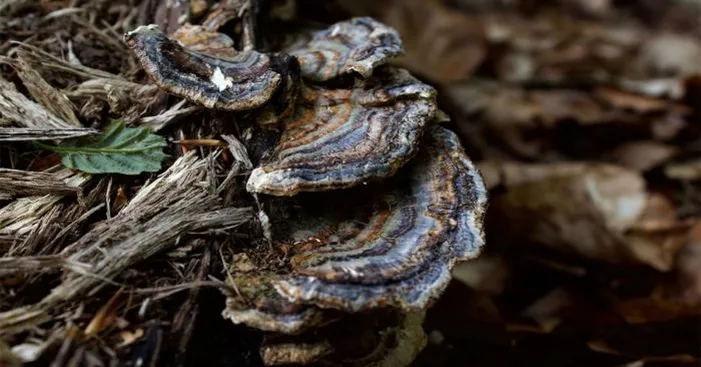
In the market, you can find multiple subproducts of the turkey tail mushroom including:
- Capsules: these come in pills and can be a good natural treatment for digestive issues.
- Drinks: made from blended turkey tail mushroom powder and very rich in vitamin C and probiotics.
- Mushroom broth: basically made from herbs, proteins, plants, turkey tail mushrooms, and a few other ingredients.
- Powder: This makes turkey tail mushroom benefits very easy to get as you can basically add 1 tsp to anything you like whether it’s pies, drinks, salads, broths…
However, if you want to buy or go out to pick turkey tail mushrooms in their natural state you need to know how to identify them.
Identifying Turkey Tail Mushrooms:
The hairy fibers:
Turkey tail mushrooms have a lot of similarities with other types of mushrooms but there are a few tips to distinguish them.
The fibrous “fuzz” on a turkey tail mushroom is more like velvet and it glows in the light and kind of look silver when light is pointed at them.
If it’s not slightly hairy or doesn’t have that velvety aspect then you are dealing with other types of mushroom from the Trametes family.
Does it have pores?
Turkey tail mushroom has pores on the underside which is also the case for other types of mushrooms like Reishi.
However, there is a similar variety of mushrooms with colored rings that resembles turkey tail and they are called Stereum ostrae.
Combining the two criteria, a “false turkey tail” or “golden curtain crust” looks very different from a turkey tail on the underside.
The only mushroom that has rings, looks like a turkey tail, and has pores on the underside are simply “Turkey tail mushrooms”.
The size of the pores:
Continuing with the same elimination process, now you eliminated the mushrooms that look like turkey tail but has no pores.
The second thing to look into is the size of the pores underside of the mushroom!
Turkey tail mushrooms tend to have tiny pores up to 8 per millimeter while the other Trametes mushrooms have large pores of about 1 per millimeter.
In nature, you usually find these two next to each other so make sure the ones you find have very tiny pores.
The freshness of the mushroom:
When turkey tail mushrooms age they become a little bit too dry, however, since they are thin they should still be flexible.
The good thing here is that most types of mushrooms dry out quickly after harvesting so the ones on the market are already a bit dry.
This can be a great tip because if the mushroom dries out and become hard and stiff then you are dealing with another Trametes mushroom and not turkey tail.
The color of the mushroom cap:
There is another turkey tail mushroom look-alike and it goes by the name “Hairy Bracket” and it’s also among the Trametes variety.
Nonetheless, these mushrooms also have rings and are shaped like a turkey tail but they only have two shades of color: gray and white.
On the other hand, a turkey tail mushroom tends to have more colors including purple, blue, yellow, brown, red …
To conclude, here’s the checklist of a turkey tail mushroom characteristics:
- Velvety fuzz that glows and looks like silverfish in the light.
- Have pores on the underside.
- The pores must be very tiny, barely visible.
- Still flexible even after it dries out.
- Multi-colored cap and not just white and gray.
Storing turkey tail mushrooms:
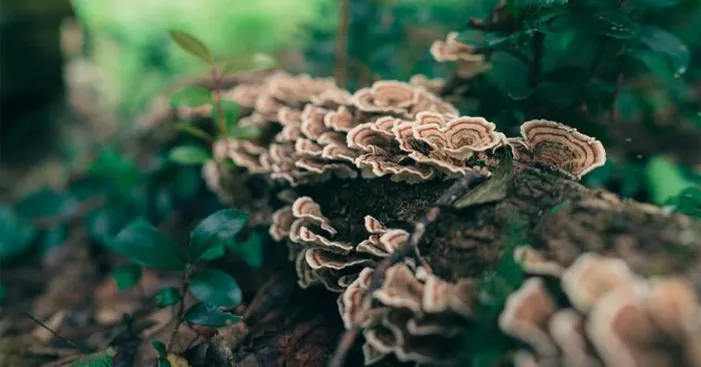
One of the easiest ways to store mushrooms, in general, is by placing them in the fridge for up to 2 months.
Nonetheless, it is not recommended to place them in plastic bags rather you should put them in a paper bag.
This is because mushrooms can interact with plastic materials which would accelerate their deterioration.
Also, it is recommended to keep mushrooms away from smelly food as they can absorb those odors and they won’t taste that great afterward.
If you want to keep them for a longer time you can simply wash them properly and then freeze them in a paper bag for up to 1 year.
If you bought canned turkey tail mushrooms you should know that they usually come with a higher sodium content and it is better if you wash them before usage.
